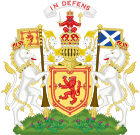Act Anent the demission of the Crown in favour of our Sovereign Lord, and his Majesty's Coronation 1567 facts for kids
| Act of Parliament | |

|
|
| Long title | Act Anent the demission of the Crown in favour of our Sovereign Lord, and his Majesty's Coronation. |
|---|---|
Quick facts for kids Dates |
|
| Royal assent | 12 December 1567 |
The Act Anent the demission of the Crown in favour of our Sovereign Lord, and his Majesty's Coronation was an important law passed by the Parliament of Scotland. This happened on December 12, 1567. This Act officially confirmed that Mary, Queen of Scots, was no longer queen. Instead, her young son, James VI, became the new king of Scotland.
Contents
What Was This Law About?
This law was about a big change in who ruled Scotland. It explained why Mary, Queen of Scots, was no longer on the throne.
Mary's Decision and James's Coronation
In 1567, Queen Mary was held at Lochleven Castle. She had been captured after the battle of Carberry Hill. On July 24, 1567, Mary signed papers giving up her crown. She handed over the rule of Scotland to her son, James VI. She also named people to act as regents, who would rule for her young son.
Mary said she was very tired and overwhelmed. She felt she could no longer handle the difficult job of being queen. She mentioned feeling "vexed, broken and disquietened" by the challenges.
On July 25, 1567, Lord Lindsay brought these papers to the Tolbooth of Edinburgh. They were read aloud for everyone to hear. The papers were read again on July 29 at the Church of the Holy Rude in Stirling. This happened just before James VI's coronation. Lord Ruthven and Lord Lindsay swore that Mary had signed the papers willingly.
James VI was crowned king on July 29, 1567, in Stirling. This was seen as a lawful event. Mary's half-brother, James Stewart, Earl of Moray, was chosen to rule as regent. A regent is someone who governs a country when the king or queen is too young. Since the Earl of Moray was not in Scotland, a group of seven temporary regents was appointed. They would rule until he returned.
The Earl of Morton took an oath to act as regent for Moray. Then, Adam Bothwell, the Bishop of Orkney, anointed the young king. This plan for regents was meant to last for 17 years. This would be until James VI was old enough to rule on his own.
The December Act of Parliament
Before Parliament met in December 1567, Moray's privy council made an important decision. They declared that the Earl of Bothwell was responsible for the death of Henry Stuart, Lord Darnley. They also stated that Mary herself was involved. This was based on letters they claimed Mary had written.
The Parliament then heard Mary's resignation letters again. They accepted the authority of Regent Moray. However, they also asked him to explain why Mary was still held at Lochleven Castle. They wanted to know the reason for her detention. They asked for her to be set free if there was no clear reason.
What Happened Next?
About a year later, a document called "Hay's Articles" said that Mary signed the papers at Lochleven. This happened after some letters, known as the casket letters, were found. Mary later said that she was forced to sign these papers. She claimed she did it because the English ambassador, Nicholas Throckmorton, told her they wouldn't be legally valid anyway.
Mary escaped from Lochleven Castle in May 1568. At Hamilton Palace, she swore that she had been forced to give up her crown. Her lawyer, Sir John Spens of Condie, wrote a strong statement. It said her abdication was not valid. It also criticized the Earl of Morton, the Earl of Moray, and others.
However, Mary's supporters were defeated at the battle of Langside. She then went to England, where she was held captive. For the next five years, her supporters in Scotland fought a civil war. They fought against the regents who ruled Scotland for James VI.
In the 1580s, Mary tried to arrange a way to return to Scotland. She wanted to rule alongside James VI. This plan was called the "association". Mary continued to say that her abdication in 1567 was forced and therefore not valid.

